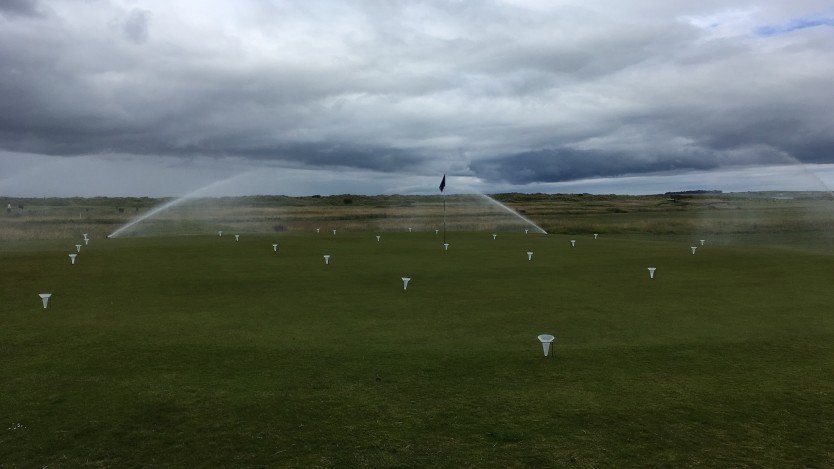Author; Giles Wardle CEng BSc MSc MIAgrE.
Irriplan Ltd.
On the vast majority of golf courses, the irrigation system will be the single most expensive tool in the greenkeepers’ inventory of maintenance equipment and the one that is most seldom replaced and least visible.
Comprising several different elements and components and often being extended and modified over time, old irrigation systems tend to become museums of the historical technical development of golf irrigation. Life expectancy for irrigation components in UK conditions is typically.
Greenkeepers are often very adept at keeping old and worn irrigation systems going long before their useful or efficient life expectancy. They often do this without golfers, committees or management really being aware of the cost and effort that is required to do so. The apparent cost is that of replacement parts and services, but there are hidden costs that are often unaccounted for, such as;
- the labour cost to make a repair or the opportunity cost of what could have been achieved with labour working on the course
- the labour/opportunity cost of manual watering to deal with deficiencies in the system
- the increased operating cost of energy and water consumption associated with an inefficient system
- disruption to the course and play due to repairing pipe bursts and leaks
- diminution in quality of the turf due to a poorly performing irrigation system
However there are some simple observations that indicate the your system is in need of upgrade or replacement.
Pipe Bursts & Leaks
This is the most obvious and disruptive manifestation of an old system in need of replacement. Most commonly this occurs with uPVC pipe networks. uPVC is a rigid pipe supplied in 6m lengths and jointed by solvent welding ie. glue. These joints in an irrigation system represent numerous potential points of failure.
Life expectancy of uPVC pipe networks is little beyond 25-30 years in benign ground conditions such as sandy links. However problems can arise much sooner where the pipes have been installed by mole-plough and pulled through stony ground. This is because uPVC is a brittle pipe and as it is pulled through the soil, sharp stones will scratch the pipe leaving a score line. With age and repeated pressure cycles, the score in the pipe can result in a split.
Pipe bursts: most obvious and disruptive manifestation of an old system
If you have an ageing uPVC pipe network which regularly bursts, this is a sure sign that it needs replacing, although sometimes there may be other hydraulic factors causing the bursts that can be mitigated.
Long Irrigation Cycle Run Times
In the early days of golf irrigation, systems were often only installed to the greens. Later, as traffic increased along with the greater demand for all year round playability and greater expectations for course presentation, irrigation systems were extended to the tees, and then approaches and then on many courses the fairways also. It is very common for the system to outgrow the capacity of the original pump and pipe network and the only way to ensure correct operation of the sprinklers is to extend the irrigation cycle run time, rather than increase the flow of the system.
If the irrigation program is over-running into the hours of play, this is often because the system has been extended beyond the hydraulic capacity of the original design.
Wet And Dry Spots
If the uniformity of coverage is poor on the irrigated surface manifesting itself with wet and dry spots, this could be due to poor sprinkler selection or inappropriate positioning of the sprinklers or the sprinklers not operating at their optimum pressure.
Old irrigation systems tended to be installed with single-nozzle, impact-driven sprinklers. However modern gear-driven sprinklers have two or three nozzles to achieve a more uniform pattern of watering and thus have a higher flow.
When replacing old impact-driven sprinklers with modern gear-driven sprinklers the mains and lateral pipe networks are often of inadequate size, resulting in excessive friction loss in the pipe and sub-optimal operating pressures. Gear-driven sprinklers also wear over time and nozzles should ideally be replaced every 10-15 years.
Sprinkler Uniformity Testing on a Green
If there are wet and dry spots on your greens, this could be attributed to inappropriate sprinkler spacing and nozzle selection or due to sprinkler replacement with new sprinklers that have flows that exceed the original design of the system.
What to do?
A complete new irrigation system represents a significant investment and is often too high a capital cost to bear for wholesale replacement in one phase of works. Many clubs soldier on, replacing failed components, repairing bursts or leaks and accept poor performance and low efficiency.
However when properly accounted for, the annual costs of such a course of action can often exceed the cost of a new system amortised over its life time. The difficulty is often not the annual cost but the large capital cost that is required for a new system.
However, it is often possible to undertake a wholesale replacement of a system with a phased program of works over a period of time to spread the cost. The nature of the phasing will depend on the type and ages of the various components of the system.
The first thing to do is to undertake an audit of the existing system and establish to objectives to be achieved by any upgrade, remedial or replacement works to be able to establish a long-term plan.
Benefits of a New System
With appropriate equipment and installation techniques a new system should have a design life of 40-50 years. With a tailored design and specification of correct equipment, the system should be more efficient, perform better and be more reliable, eliminating the labour cost and time for repairs, allowing the greens staff to spend more time working on course maintenance and presentation.
Whilst these benefits can often be difficult to quantify in exact financial terms, the improvements are always tangible.
About the author:
Giles Wardle is a Chartered Engineer and founder of Irriplan. The company specialises in the planning, design and implementation of irrigation systems and water supplies to the golf and sports turf industries throughout the UK, Europe and beyond. www.irriplan.net For a complimentary initial consultation and irrigation review contact [email protected] m: +44 (0) 777 154 635
By GCMA



